Students can Download Sanskrit Lesson 18 नाट्यांशाः Questions and Answers, Summary, Notes Pdf, Activity, KSEEB Solutions for Class 10 Sanskrit helps you to revise the complete Karnataka State Board Syllabus and score more marks in your examinations.
Karnataka State Syllabus Class 10 Sanskrit नंदिनी Chapter 18 नाट्यांशाः (नाट्यशास्त्रम्)
नाट्यांशाः Questions and Answers, Summary, Notes
अभ्यासः
I. एकवाक्येन उत्तरं लिखत ।
प्रश्न 1.
नाट्ये कति रसाः स्मृताः ?
उत्तरम्
नाट्ये नवरसाः स्मृताः ।
प्रश्न 2.
नाटकस्य गरिमाणं कः अवर्णयत् ?
उत्तरम्
नाटकस्य गरिमाणं कालिदासः अवर्णयत् ।
![]()
प्रश्न 3.
नाट्यशास्त्रस्य रचयिता कः?
उत्तरम्
नाट्यशास्त्रस्य रचयिता भरतमुनिः ।
प्रश्न 4.
शान्तरसस्य स्थायिभावः कः?
उत्तरम्
शान्तरसस्य स्थायीभावः शमः।
II. चतुर्थं पदं लिखत ।
- हास्यम् – हासः करुणः → शोकः ।
- क्रोधः – स्थायिभावः → भयानकः – रसः ।
- अर्जुनः – धीरोदात्तः → दुर्योधनः – धीरोद्धतः।
III. लकार-पुरुष-वचनानि लिखत ।
- वक्ष्यामि = लुट्लकारः – उत्तमपुरुषः – एकवचनम् ।
- क्रियते = लट्लकारः – प्रथमपुरुषः – एकवचनम् ।
- अवर्णयत् – लङ्लकारः – प्रथमपुरुषः – एकवचनम् ।
- दृश्यते – लट्लकारः – प्रथमपुरुषः – एकवचनम् ।
IV. दशवाक्यैः उत्तरं संस्कृतभाषया, कन्नडभाषया आङ्ग्लभाषया वा लिखत ।
प्रश्न 1.
पाठ्यभागे निरूपितान् नाटयांशान् सङ्ग्रह लिखत ।
उत्तरम्

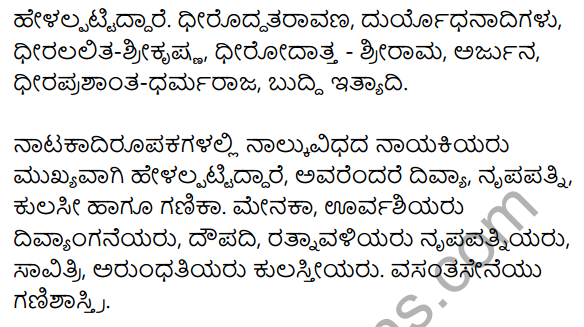
Amorous (erotic love), jest, sympathy, frightfulness, bravery, terror, terrific, wonder, peace (calmness) are the nine types of rasas (aesthetic sentiments) which are found in dramas as well as kavya’s.
![]()
How Navarasas are there in kavyas, like that enjoyment (involvement), joking, sadness, anger(enmity), enthusiasm, fear, negligence, wonder, self-control these are called as nine types of sthaibhavas (basic sentiments).
Four kinds of abhinayas (acting, expression) in the dramas. They are – Angika (bodily expression), vachika (linguistic expression), ahaarya (costumes of the characters and stage decoration), sattvika (voluntary changes) to express the deepest emotions of a character.
Musical tones are seven in number. They are Nishada, Rishabha, Gandhara, shadga, madhyama, dhivata and panchama. Musical performance, particularly its application to vocal and instrumental compositions.
An instrument by name Aatodya is divided into four types. They are Tata, anavaddha, ghana and sushira.
Among the four types of musical instruments – the stringed musical instrument is called as Tata, mridanga (drums) etc are called as anavaddha. Bell-type of instruments is called as ghana. Bamboo made flute etc. are called a sushira musical instrument. drum=cylindrical structured musical instrument.
Heros are four in types, they are – Dheeroddhatta(brave and ruler), dheeralalitha (brave but not ruler), dheerashanta (brave with self-confidence), dheerashantha (brave with arrogance). Ravana, Duryodhana is dheeroddhatas, Srikrishna is dheeralalitha, Srirama, Arjuna is dheerodattas, Dharmaraja, buddha is dheeraprashantha heros.
![]()
Heroines are four types. They are Divya (celestial), nrupapatni(queen), kulastree (born in a noble family, noble lady), ganika stree (harlot).
- Divya – Menaka, Urvashi
- Nrupapatni – Draupadi, Ratnavali
- Kulastree – Savitri, Arundhathi
- Ganika – Vasantasena.
इतरप्रश्नाः
I. सूक्तम् उत्तरं चित्वा लिखत ।
प्रश्न 1.
नाट्यशास्त्रस्य रचयिता एषः ।
(a) भरतमुनिः
(b) भरद्वाजः
(c) भर्तृहरिः
(d) भारद्वाजः
प्रश्न 2.
नवरसाः अत्र दृश्यन्ते ।
(a) ग्रन्थेषु
(b) नाटकादिरूपकेषु
(c) पद्येषु
(d) वेदेषु
प्रश्न 3.
नाट्ये अभिनयाः एवंविधाः सन्ति ।
(a) बहुधाः
(b) त्रिविधाः
(c) चतुर्विधाः
(d) सप्तविधाः
![]()
प्रश्न 4.
एषा कुलस्त्री इति ख्याता ।
(a) मेनका
(b) द्रौपदी
(c) वसन्तसेना
(d) सावित्री
प्रश्न 5.
एषः धीरोदात्तः नायकः ।
(a) वत्सराजः
(b) श्रीरामः
(c) श्रीकृष्णः
(d) बुद्धः
प्रश्न 6.
सुषिरः अनेन निर्मितः अस्ति ।
(a) लोहेन
(b) धातुना
(c) वंशेन
(d) मृण्मयेन
प्रश्न 7.
शरीरसम्बन्धी अभिनयः एवं कथ्यते ।
(a) आङ्किकः
(b) वाचिकः
(c) आहार्यः
(d) वर्णविन्यासः ।
![]()
प्रश्न 8.
एतावन्तः स्वराः सन्ति ।
(a) षट
(b) सप्त
(c) अष्ट
(d) नव
प्रश्न 9.
ततम् → तन्त्रीवाद्यम् ; मृदङ्गादयः → …….। अत्र चतुर्थपदम् इदम् अस्ति ।
(a) घनः
(b) सुषिरः
(c) अनवद्धम्
(d) वाद्यम्
प्रश्न 10.
नृपपत्नी एषा अस्ति ।
(a) मेनका
(b) ऊर्वशी
(c) रम्भा
(d) द्रौपदी
II. संयोज्य लिखत ।
अ – आ
1. श्रृङ्गारः – 1. शमः
2. हास्यः – 2. विस्मयः
3. करुणः – 3. जुगुप्सा
4. रौद्रः – 4. भयम् वीरः
5. वीरः – 5. उत्साहः
6. भयानकः – 6. क्रोधः
7. बीभत्सः – 7. शोकः
8. अद्भुतम् – 8. हासः
9. शान्तः – 9. रतिः
उत्तरम्:
१ – ९, २ – ८, ३ – ७, ४ – ६, ५ – ५, ६ – ४, ७ – ३, ८ – २, ९ – १
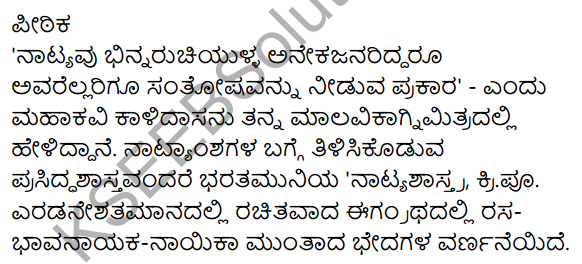
![]()
Introduction
‘The dramatic art is the one chief amusement of the people, albeit they have diverse tastes’ these are the words of king of poets Kalidasa, the composer of the book मालविकाग्निमित्रम्. Bharatamuni wrote नाट्यशास्त्रम् somewhere around 200 B.C This book deals with all the parts of dramas. This is the only book which refers Rasa-BhavaNayaka (hero) – Nayika (heroine) etc. first time in the history.
पीठिका
‘नाट्यं भिन्नरुचेर्जनस्य बहुधाप्येकं समाराधनम्’ इति महाकविः कालिदासः मालविकाग्निमित्रनाटके नाट्यस्य गरिमाणम् अवर्णयत् । नाट्याशानां प्रतिपादक प्रसिद्धं शास्त्रं भरतमुनिविरचितं ‘नाट्यशास्त्रम्’ । तस्मात् उद्धृते प्रस्तुत भागे रसभाव नायक-नायिका भेदानां परिचयः संक्षेपेण कार्यते ।
कविकाव्यविचारः
- कविः – भरतमुनिः ।
- कालः – क्रि.पू. द्वितीयशतकम् ।
- कृतिः – नाट्यशास्त्रं ।
नाट्यांशाः Summary in Kannada
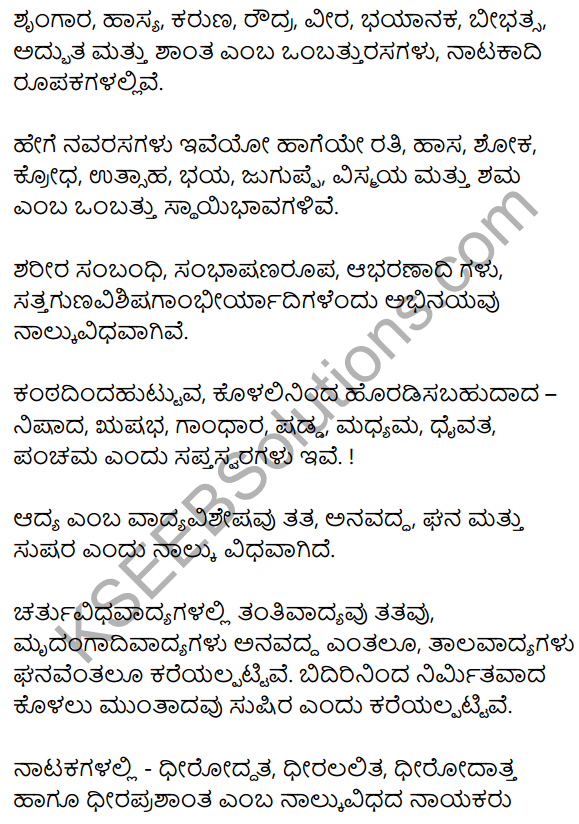
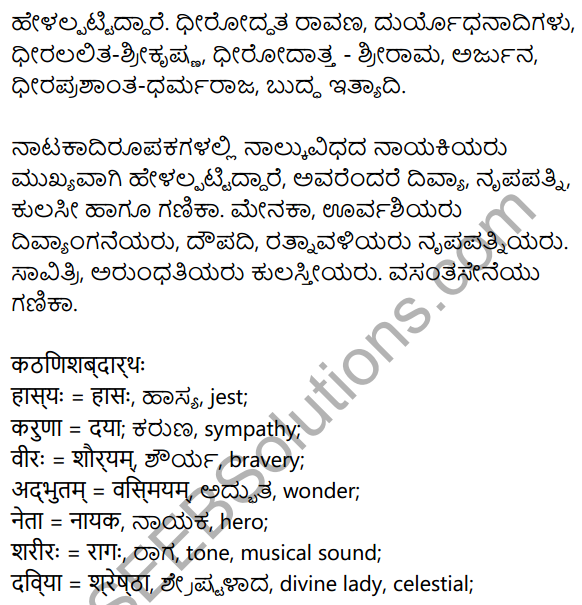
नाट्यांशाः Summary in English
Amorous (erotic love), jest, sympathy, frightfulness, bravery, terror, terrific, wonder, peace (calmness) are the nine types of rasas (aesthetic sentiments) which are found in dramas as well as kavya’s.
![]()
How Navarasas are there in kavya’s, like that enjoyment (involvement), joking, sadness, anger (enmity), enthusiasm, fear, negligence, wonder, self-control these are called as nine types
of sthaibhavas (basic sentiments).
Four kinds of abhinayas (acting, expression) in the dramas. They are – Angika (bodily expression), vachika (linguistic expression), ahaarya (costumes of the characters and stage decoration), sattvika (voluntary changes) to express the deepest emotions of a character.
Musical tones are seven in number. They are Nishada, Rishabha, Gandhara, shadga, madhyama, dhivata and panchama. Musical. performance, particularly its application to vocal and
instrumental compositions.
An instrument by name Aatodya is divided into four types. They are Tata, anavaddha, ghana and sushira.
Among the four types of musical instruments – the stringed musical instrument is called as Tata, mridanga (drums) etc are called as anavaddha. Bell-type of instruments is called as ghana. Bamboo made flute etc. are called a sushira musical instrument.
drum = cylindrical structured musical instrument.
Heros are four in types, they are – Dheeroddhatta(brave and ruler), dheeralalitha (brave but not ruler), dheerashanta (brave with self-confidence), dheerashantha (brave with arrogance). Ravana, Duryodhana is dheeroddhatas, Srikrishna is dheeralalitha, Srirama, Arjuna is dheerodatias, Dharmaraja, buddha is dheeraprashantha heros.
Heroines are four types. They are Divya (celestial), nrupapatni(queen), kulastree (born in a noble family, noble lady), ganika stree (harlot).
- Divya – Menaka, Urvashi
- Nrupapatni – Draupadi, Ratnavali
- Kulastree – Savitri, Arundhathi
- Ganika – Vasantasena.
![]()
नाट्यांशाः Summary in Sanskrit
सारांशः
1. शृङ्गरहास्यकरुणाः रौद्रवीरभयानकाः ।
बीभत्साद्भुतशान्ताश्च नव नाट्ये रसाः स्मृताः ।।
2. रतिर्हासश्च शोकश्च क्रोधोत्साही भयं तथा।
जुगुप्साविस्मयशमाः स्थायिभावाः प्रकीर्तिताः।।
3. आङ्गिको वाचिकश्चैव आहार्यः सात्विकस्तथा।
चत्वारोऽभिनया ह्येते विज्ञेया नाट्यसंश्रयाः।।
4. शरीरा वैणवाश्चैव सप्त षड्जादयः स्वराः।
निषादर्षभगान्धारमध्यपञ्चमधैवताः ।।
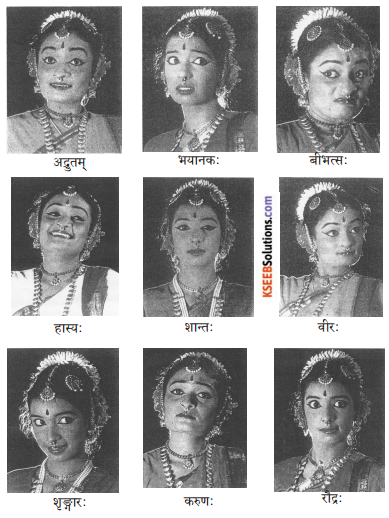
5. ततं चैवानवद्धञ्च घनं सुषिरमेव च ।
चतुर्विधं च विज्ञेयम् आतोद्यं लक्षणान्वितम् ।।
![]()
6. ततं तन्त्रीगतं ज्ञेयम् अनवद्धं तु पौष्करम् ।
घनस्तु तालो विज्ञेयः सुषिरो वंश एव च।।
7. धीरोद्धतो धीरलितो धीरोदात्तस्तथैव च ।
धीरप्रशान्तश्चैवेति नायकाः नाटकाश्रयाः।।
8. नाचिकाश्चैव वक्ष्यामि चतस्रः पुनरेव तु।
दिव्या च नृपपत्नी च कुलस्त्री गणिका तथा ।।